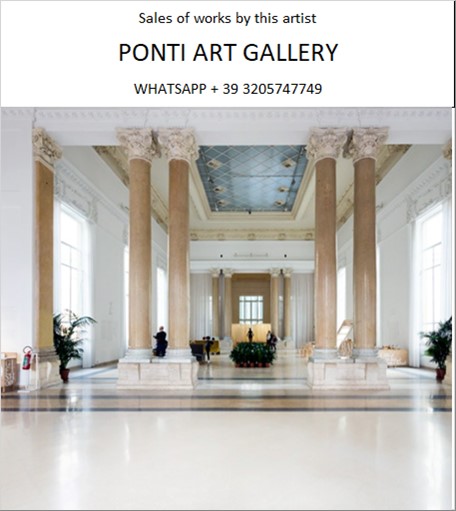Ponti Art Gallery is interested in buying and selling works
of art by this artist.

Henry Cartier-Bresson Biography
Henri Cartier-Bresson, born on August 22, 1908, in Chanteloup-en-Brie, France, was a visionary artist whose profound influence on the art of photography is unparalleled. His work, characterized by its humanity and candid nature, helped establish photojournalism as an art form. Cartier-Bresson's unique approach to capturing the "decisive moment" has left a lasting legacy that continues to inspire photographers around the world.
From an early age, Cartier-Bresson was immersed in the arts. His family's affluence allowed him the freedom to explore various artistic avenues. His father was a successful textile manufacturer, and his mother came from a family of cotton merchants. This financial stability provided him with the opportunity to study, travel, and experiment, which was a rarity for aspiring artists of his time. Despite his privileged background, Cartier-Bresson was acutely aware of his advantages and used his resources to finance large projects and support other artists.
Initially aspiring to become a painter, Cartier-Bresson studied under his uncle, an accomplished painter, and later at a private art academy in Paris, where he was exposed to Cubism and classical art. However, painting alone did not satisfy Cartier-Bresson's creative urges. He destroyed most of his early paintings, although a few survived and occasionally appear at renowned auction houses.
Cartier-Bresson's artistic journey took a pivotal turn when he discovered the Leica camera in 1932. This small, unobtrusive camera became his tool of choice, allowing him to capture spontaneous moments with ease. He developed a fascination with Surrealism and was influenced by the movement's use of photography and montage techniques. Despite his close affiliations with famous Surrealists like Man Ray, Cartier-Bresson never officially joined the movement, heeding the advice of his colleague Robert Capa to avoid limiting labels.
His photographic style was heavily influenced by his background in painting, with a strong emphasis on composition and geometric balance. Cartier-Bresson preferred to shoot in black and white, believing it allowed him to better capture the essence of a scene without the distractions of color. He was a firm believer in the concept of the "decisive moment," which he described as the precise instant when all elements of a composition align perfectly, revealing the essence of the event.
Cartier-Bresson's career highlights include co-founding the Magnum Photos agency in 1947, documenting significant historical events such as the Chinese Civil War and Indian independence, and publishing numerous photo books, including "The Decisive Moment." His empathetic approach and ability to capture pivotal moments in history earned him worldwide recognition and respect.
Throughout his career, Cartier-Bresson photographed many prominent figures, but he himself was known for his shyness and desire for privacy. He disliked being photographed and often shunned publicity. In the latter part of his life, he turned his focus to drawing and painting, expressing his creativity through these mediums until his death on August 3, 2004, in Céreste, France.
Cartier-Bresson's legacy is preserved through the Henri Cartier-Bresson Foundation, established in Paris with his wife and daughter. His work has been exhibited in major institutions worldwide, and his photographs continue to be a source of inspiration and study for artists and photographers alike.
Henri Cartier-Bresson's approach to photography was both intuitive and deliberate. He often referred to his camera as a sketchbook, an instrument of intuition and spontaneity. His philosophy was that photography should capture the reality of the world, reflecting its beauty, complexity, and contradictions. His images, often taken with a small, handheld camera, are celebrated for their composition, clarity, and ability to convey profound human experiences.
Cartier-Bresson's influence extends beyond individual photographers to the broader field of photography. His establishment of Magnum Photos provided a platform for many of the world's most talented photographers, ensuring that his legacy would continue to live on for generations to come. His commitment to capturing the decisive moment and his keen eye for composition have solidified his place as one of the most important figures in the history of photography.
Henry Cartier-Bresson Quotes
and Sales of Works
Ponti Art Gallery selects and deals with paintings by the
artist. Upon request, we provide free estimates and
evaluations, communicate prices, quotations, and current
market values.
If you are interested in BUYING or SELLING works by the
artist, contact us immediately.
If you wish to sell or receive an evaluation of the
works:
Send us a frontal photo of the painting, one of the back,
and one of the signature. Also, indicate the dimensions of
the work. Inform us about the purchase origin of the work
and any kind of available documentation (purchase
receipts, certificates of authenticity, publications). One
of our operators will respond to you on the same day. We
guarantee maximum confidentiality and extreme
professionalism.
If you wish to purchase works by the painter: Contact us
and let us know your request. We will inform you about the
available works. We also offer the possibility to
subscribe to our NEWSLETTER, through which you will be
informed at the beginning of each month about the latest
acquisitions of the art gallery.
You can send us pictures of the work:
